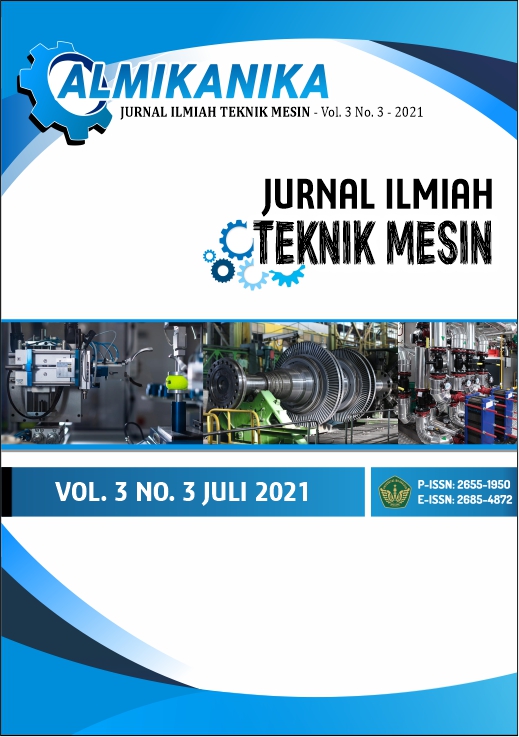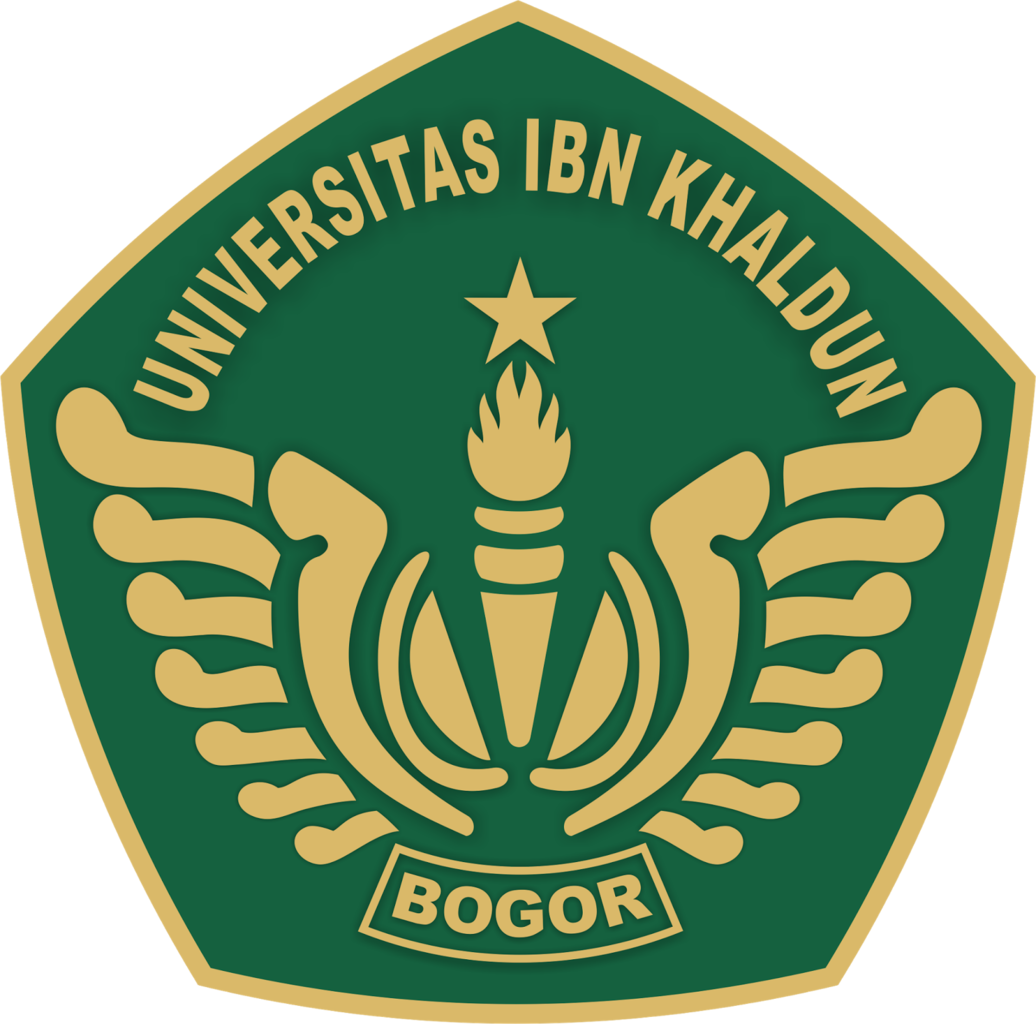ANALISIS DISTRIBUSI UKURAN PARTIKEL TEH HIJAU HASIL EKSTRAKSI DENGAN METODE ULTRASONIC ASSISTED EXTRACTION (UAE) COLD BREW
DOI:
https://doi.org/10.32832/almikanika.v3i3.6710Abstract
Ekstraksi teknik cold brew mulai berkembang dikalangan masyarakat yaitu menggunakan air bersuhu ruang yang didiamkan 6-18 jam. Metode ini digunakan untuk menyeduh kopi atau teh dengan kualitas yang baik tapi membutuhkan waktu yang cukup lama. Oleh karena itu perlu metode ekstraksi yang lebih cepat tanpa mengurangi kualitas produk yang dihasilkan. Salah satunya yaitu Ultrasonic assisted extraction (UAE) merupakan metode ekstraksi berbantu ultrasonik yang dapat menghasilkan ekstrak cukup baik pada suhu ruang dalam waktu yang lebih singkat bahkan mampu menghasilkan ukuran partikel dalam skala nanometer. Untuk itu, dilakukan penelitian ekstraksi teh hijau menggunakan metode UAE dalam temperatur rendah (dibawah suhu ruang). Tujuan Penelitian ini adalah mengetahui pengaruh suhu dan waktu ekstraksi terhadap ukuran partikel menggunakan UAE cold brew serta menentukan waktu dan suhu optimum pengekstraksi untuk menghasilkan berat terekstraksi tertinggi dan melakukan analisis distribusi ukuran partikel ekstrak yang dihasilkan. Proses UAE menggunakan air suhu (10, 15, 20 ºC) dan waktu (5, 10, 30 menit). Sebagai kontrol dilakukan ekstraksi maserasi cold brew menggunakan suhu ruang selama 12 jam didiamkan pada lemari pendingin dan hot brew suhu 70ºC selama 10 menit. Analisis kepekatan warna dilakukan untuk menentukan sample yang akan diuji PSA. Hasil analisis kepekatan warna menunjukan ekstraksi UAE suhu 10ºC dengan variasi waktu 5,15,30 menit yang paling sesuai dengan karakteristik larutan teh hijau. Uji PSA menghasilkan ukuran paling kecil pada suhu 10ºC selama 30 menit dengan rata-rata ukuran 293.64 nm. Waktu dan suhu optimum untuk menghasilkan berat terekstraaksi terbanyak pada suhu 20ºC 30 menit sebesar 0,82 gram dari 6 gram sample teh hijau. Hasil ini menunjukan ekstraksi UAE dapat mempersingkat waktu, meningkatkan berat terekstraksi dan menghasilkan ukuran nanometer.
Kata kunci : Cold Brew; Ekstraksi; PSA; Teh Hijau; UAE
ABSTRACT
The extraction of cold brew techniques has begun to develop among the community, by using room temperature water that is left to rest for 6-18 hours. This method is used to brew coffee or tea with good quality but it takes a long time. Therefore, it needs a faster extraction method without reducing the quality of the product produced. One of them is Ultrasonic assisted extraction (UAE) which is an ultrasonic-assisted extraction method that can produce extracts quite well at room temperature in a shorter time and is even able to produce particle sizes on the nanometer scale. For this reason, a research on green tea extraction was carried out using the UAE method at low temperature (below room temperature). The purpose of this study is to determine the effect of temperature and extraction time on particle size using UAE cold brew and to determine the optimum extraction time and temperature to produce the highest extracted weight and analyze the particle size distribution of the extracts. The UAE process uses water temperature (10, 15, 20 ºC) and time (5, 10, 30 minutes). As a control, the cold brew maceration extraction was carried out using room temperature for 12 hours, left in the refrigerator then hot brew at 70ºC for 10 minutes. Color density analysis is carried out to determine the sample to be tested for PSA. The results of the color density analysis showed that the UAE extraction temperature was 10ºC with a time variation of 5.15.30 minutes which was the most suitable with the characteristics of the green tea solution. The PSA test produced the smallest size at 10ºC for 30 minutes with an average size of 293.64 nm. The optimum time and temperature to produce the most extracted weight were at 20ºC 30 minutes at 0.82 grams from 6 grams of green tea samples. These results showed that the UAE extraction can shorten the time, increase the weight extracted and produce a nanometer size.
Keywords : Cold Brew; Extraction; PSA; Green tea; UAE
References
Abdullah, M., Virgus, Y., Nirmin dan Khairurrijal, 2008, Sintesis Nanomaterial, Jurnal Nanosains & Nanoteknologi, Jurnal Nanosains & Nanoteknologi, vol. 1 no.2,hh 33–57.
Anggraini, T 2017, Proses dan Manfaat Teh, Padang, Erka.
Aryadi F, Wahyuni S, Rejeki S, 2017, Analisis Organoleptik Produk Teh Celup Tawaloho (Spondias Pinnata.), Jurnal Sains dan Teknologi Pangan (JSTP) ISSN: 2527-6271, vol. 2, no.5 P.792-799.
Castro MDL, Garcia JLL, 2004, Ultrasonic-assisted soxhlet extraction : an expeditive approach for solid sample treatment, application to the extraction of total fat from oleaginous seeds. J Chromatogr A. 1034:237-242.
Chacko SM, Thambi PT, Kuttan R dan Nishigaki, 2010, Benefical Effects Of Green Tea : A Literature Review. Apr: 5:13.
Das, C. dan Chatterjee, S., 2018, Evaluation of Antioxidant Status in Cold Brewed Tea with Respect to Hot Decoction: Comparative Study Between Green and Black Varieties, International Journal of Pharmacognosy and Phytochemical Research, 9(07), 961–964.
Dewi, K., 2008, Artikel Pengaruh Ekstrak Teh Hijau (Camellia Sinensis var. Assamica) Terhadap Penurunan Berat Badan, Kadar Trigliserida dan Kolesterol Total Pada Tikus Jantan Galur Wistar, JKM vol.7 no. 2, hh.155-162.
Dharmawan, A., 2017, Teknik Seduhan Kopi Sensasi Kesegaran Kopi Cold Brewing, Warta pusat penelitian kopi dan kakao indonesia, hh.14–16.
Fuadi, A., 2012, Ultrasonik Sebagai Alat Bantu Ekstraksi Oleoresin Jahe, Jurnal Teknologi, vol.12 no.1, hh. 14–21.
Jos, B., Pramudono, B. dan Apriaonto, 2011, Ekstraksi Oleoresin Dari Kayu Manis Berbantu Ultrasonik Dengan Menggunakan Pelarut Alkohol, Reaktor, vol.13 no. 4, hh. 231–236.
Kuldiloke, J., 2002, Effect of ultrasound, temperature and pressure treatments on enzyme activity and quality indicators of fruit and vegetable juices, Publishing in journal of food engineering, 138.
Liu, Q.M., Yang, X.M., Zhang, L. dan Majetich, G., 2010, Optimization of ultrasonic-assisted extraction of chlorogenic acid from Folium eucommiae and evaluation of its antioxidant activity, Journal of Medicinal Plants Research, vol. 4(23), pp. 2503–2511.
Lusi, 2011, Cara Mengetahui Ukuran Suatu Partikel, dilihat 28 Februari 2011, https://www.academia.edu/17587816/Cara-mengetahui-ukuran-suatu-partikel.
Martien, R., Adhyatmika, Irianto, I.D.K., Farida, V. dan Sari, D.P., 2012, Perkembangan Teknologi Nanopartikel Sebagai Sistem Penghantaran Obat, Majalah Farmaseutik, vol. 8, no. 1, 133–144.
Mason, T.J. dan Cintas, P., 2002, Sonochemistry, Handbook of Green Chemistry and Technology.
Rusli SD, Rahmawan D., 1988, Pengaruh cara pengirisan dan tipe pengeringan terhadap mutu jahe kering, Bull Penelitian dan Tanaman Rempah dan Obat, vol. 3 no. 2, 80-83.
Sholihah, M., Ahmad, U. dan Budiasta, I.W., 2017, Aplikasi Gelombang Ultrasonik untuk Meningkatkan Rendemen Ekstraksi dan Efektivitas Antioksi dan Kulit Manggis, Jurnal Keteknikan Pertanian (JTEP), vol. 5, no.2, p 161-168.
Sulistiyono, E., Manaf, A. dan Firdiyono, F., 2012, Pengaruh Media Suspensi Terhadap Proses Ultrasonic Milling Pada Partikel Hydromagnesite, Majalah Metalurgi, vol. 6,135–140


















